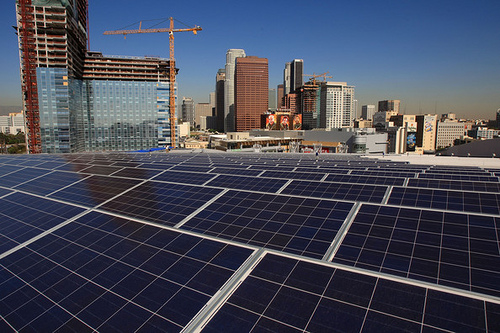An academic study jointly authored by UCLA and USC research teams finds that Los Angeles has a significant trained workforce ready to perform clean-energy solar jobs, but that city leaders have so far failed to enact policies that would take advantage of this resource and put city residents to work.
Further, the study finds that the areas in Los Angeles with the greatest potential for rooftop solar power – and thus the greatest capacity to support solar-related jobs – include many areas suffering from high unemployment and economic need.
“Unless civic leaders ramp up efforts to expand solar programs, the city and region face the prospect of being left behind,” states the report, Empowering LA’s Solar Workforce: New Policies that Deliver Investments and Jobs. “This report is, above all, a wake-up call to policymakers to make certain they are utilizing an important workforce segment – and creating policies that will put qualified people to work.”
The report, presented by the LABC Institute, will be formally released at the LA Business Council’s “Building LA’s Workforce” Summit at UCLA on Nov. 16. It will be discussed at the event by a panel that includes three leading mayoral candidates– City Council President Eric Garcetti, Controller Wendy Greuel and Councilwoman Jan Perry.
The study finds that, while California has set a goal of generating 33% of its energy from renewable energy by 2020, the region lacks sound policies to meet these goals and employ ready green-economy workers. In fact, the Los Angeles Department of Water and Power (LADWP) has one of the weakest solar track records among major California utilities, generating less than one sixth as much solar power per customer as the state leader, Southern California Edison.
The report urges officials to adopt a rooftop solar energy program known as a solar FiT (or feed-in tariff) that enables business owners and residents to install solar panels on their rooftops and sell surplus energy to the local utility. Such a program has been endorsed by a coalition of environmental groups, labor leaders, business organizations and other stakeholders.
The UCLA and USC research teams – led by J.R. DeShazo of the UCLA Luskin Center and Manuel Pastor of the USC Program for Environmental and Regional Equity – had previously established the need for a rooftop solar program in Los Angeles, and its potential to benefit low-income Angelenos. A robust program could create $2 billion in local investment and create 16,000 job-years with a minimal impact on ratepayers. Past studies are available at LABC’s website, www.labusinesscouncil.org/sustainability.
The region’s significant number of ready-to-work solar professionals is the result of plentiful local training programs, run by organizations as varied as Homeboy Industries, IBEW Local 11, and the Los Angeles Trade and Technical College. Roughly 2,200 people are trained each year in Los Angeles County alone for jobs in solar panel installation, design, sales and other areas. The study breaks new ground in examining these programs, and argues that city officials can enact policies to give these workers greater opportunity to find work – while growing an essential new industry.
“What’s so compelling about this research is that it matches the need for good, local jobs and the mandate for clean, renewable energy,” said Los Angeles Business Council President Mary Leslie, whose group has been pushing for a robust rooftop solar program ever since Mayor Villaraigosa called for it three years ago. “We were astonished to see how cleanly the job-creation potential, the social equity aspect and the environmental imperative go hand-in-hand.”
Through the use of advanced mapping techniques, USC researchers were able to determine the areas of greatest solar potential – primarily, those sections of Los Angeles with a high density of large rooftops, whether commercial, industrial or multifamily residential. Further, they were able to overlay those areas with those communities suffering from high unemployment and high poverty.
The result is a clear picture of which areas stand to gain the most from expanded solar development – and also those that have the greatest need. Solar “hotspots” exist in the San Fernando Valley, eastern Los Angeles, and areas west of downtown, including Hollywood. In many cases, solar training programs are located near these “hotspots” – and near areas of great need.
“Los Angeles has a unique confluence of characteristics: abundant sunshine, a trained workforce and tremendous economic need,” said USC’s Pastor. “The right policies will enable Los Angeles to be a leader in both solar energy and in putting people to work.”
The report also includes an analysis from UCLA that sheds light on the performance of California utilities in generating solar power under the California Solar Initiative, or SB 1. In addition to determining that LADWP lags far behind other local utilities in generating solar power, it finds that the city-owned utility also ranks nearly last in the cost per solar job created. Whereas Burbank could create one job-year at a cost of $36,000, LADWP’s cost was more than $129,000.
“These figures tell us that LADWP has not been as successful as other local utilities either in bringing solar to market or in its efficiency in doing so,” said UCLA’s DeShazo. “Looking forward, policy makers can take note of past performance as they weigh the proper steps moving ahead.”
The report advocates a solar FiT as part of a comprehensive approach to advancing solar development in Los Angeles. Unlike existing rooftop solar programs, the FiT is specifically designed to generate a net energy increase– not simply to offset the user’s needs.
“The solar FiT can create hundreds if not thousands of clean energy plants right here in Los Angeles,” said LABC Chairman Jacob Lipa. “By working in partnership with the private sector, the solar FiT enables a far greater reach than public sector programs alone. The benefits in jobs and economic impact are tremendous.”
The report calls for making use of federal and state subsidies to grow the emerging solar industry; channeling benefits to disadvantaged communities; engaging a multi-sector workforce development partnership; advocating for continued funding of green training programs; and more.
The UCLA/USC report closes with a clear sense of purpose:
“We have a ready market, and a ready set of policies. Generating solar jobs will require continued strong implementation of energy goals and incentivization of the local market. It will require that local utilities be made accountable for their current solar efforts by policymakers who can assess the job-creation impacts – and their costs – relative to desired outcomes. And it will require that equity and the environment come together in programs to connect disadvantaged workers with solar employment.”
To download the report, please click here. BD+C
Related Stories
Office Buildings | Jul 29, 2015
Design plans for Fannie Mae’s new HQ revealed
The developer/owner, Carr Properties, envisions a 1-million-sf plus mixed-use center with a large retail pavilion.
Sports and Recreational Facilities | Jul 29, 2015
Milwaukee Bucks arena deal approved by Wisconsin state assembly
Created by Milwaukee firm Eppstein Uhen Architects and global firm Populous, the venue will be built in downtown Milwaukee. Its design draws inspiration from both Lake Michigan, which borders Milwaukee, and from aspects of basketball, like high-arcing free throws.
Contractors | Jul 29, 2015
Consensus Construction Forecast: Double-digit growth expected for commercial sector in 2015, 2016
Despite the adverse weather conditions that curtailed design and construction activity in the first quarter of the year, the overall construction market has performed extremely well to date, according to AIA's latest Consensus Construction Forecast.
University Buildings | Jul 28, 2015
OMA designs terraced sports center for UK's Brighton College
Designs for what will be the biggest construction project in the school’s 170-year history feature a rectangular building at the edge of the school’s playing field. A running track is planned for the building’s roof, while sports facilities will be kept underneath.
High-rise Construction | Jul 28, 2015
Work begins on KPF's 'flared silhouette' tower in Manhattan
The 62-story, 157-unit luxury condo tower widens at the 40th floor, resulting in a gently flared silhouette, accented by a sculpted crown.
Museums | Jul 28, 2015
MUST SEE: Zaha Hadid's latest museum project is built into a mountain
The museum, dedicated to legendary mountaineer Reinhold Messner, is embedded within Mount Kronplatz in northern Italy.
Smart Buildings | Jul 27, 2015
Perkins+Will imagines new opportunity for Atlantic City
The architecture giant believes it has a solution that could put Atlantic City’s existing infrastructure to good use—by turning the Jersey Shore city into a research center for climate change and coastal resiliency.
Retail Centers | Jul 27, 2015
Fish-shaped shopping mall designed for odd plot of land in China
The mall, in Qinshui, a city in China’s Shanxi province, will fit within the 250x30-meter dimensions surrounded by parallel roads and two converging rivers.
Performing Arts Centers | Jul 27, 2015
Vox Populi: Netherlands municipality turns to public vote to select design for new theater
UNStudio’s Theatre on the Parade received nearly three-fifths of votes cast in contest between two finalists.
Multifamily Housing | Jul 27, 2015
Miami developers are designing luxury housing to cater to out-of-town buyers and renters
The Miami Herald reports on several new multifamily projects, including the Paramount Miami Worldcenter, whose homes include maid’s rooms, larger terraces, boutique-size closets, and guest suites.

















